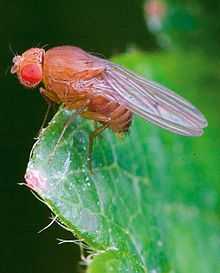Drosophila simulans
| Drosophila simulans | |
|---|---|
 | |
| Drosophila simulans Adult Female | |
| Scientific classification | |
| Kingdom: | Animalia |
| Phylum: | Arthropoda |
| Class: | Insecta |
| Order: | Diptera |
| Genus: | Drosophila |
| Subgenus: | Sophophora |
| Species group: | melanogaster group |
| Species subgroup: | melanogaster subgroup |
| Species complex: | simulans complex |
| Species: | D. simulans |
| Binomial name | |
| Drosophila simulans Sturtevant, 1919 | |
Drosophila simulans is a species of fly closely related to D. melanogaster and which belongs to the same melanogaster species subgroup. Its closest relatives are D. mauritiana and D. sechellia. This species was discovered by the fly geneticist Alfred Sturtevant in 1919, when he noticed that the flies used in Thomas Hunt Morgan's laboratory at the Columbia University were actually two distinct species: D. melanogaster and D. simulans. Males differ in the external genitalia, while trained observers can separate females using colour characteristics. D. melanogaster females crossed to D. simulans males produce sterile F1 females and no F1 males. The reciprocal cross produces sterile F1 males and no female progeny.
D. simulans was found later to be closely related to two island endemics, Drosophila sechellia and Drosophila mauritiana. D. simulans will mate with these sister species to form fertile females and sterile males, a fact that has made D. simulans an important model organism for research into speciation.
Studies have obtained evidences that paternal leakage is an integral part of the inheritance of this species.[1]
References
- ↑ Wolff, J N; Nafisinia, M; Sutovsky, P; Ballard, J W O (2012). "Paternal transmission of mitochondrial DNA as an integral part of mitochondrial inheritance in metapopulations of Drosophila simulans". Heredity 110 (1): 57–62. doi:10.1038/hdy.2012.60. PMC 3522233. PMID 23010820.
- Sturtevant, A.H. 1919. A new species closely resembling Drosophila melanogaster. Psyche 26: 153–155.
- Sturtevant, A.H. The North American Species of Drosophila. Carnegie Institute of Washington, 1921.
External links
- Drosophila simulans at the Washington University in St. Louis Genome Sequencing Center
- Drosophila simulans at FlyBase
- Drosophila simulans at Ensembl Genomes Metazoa